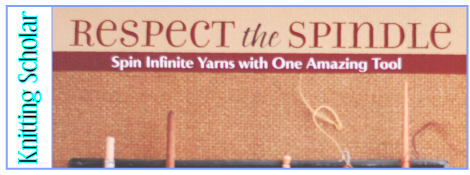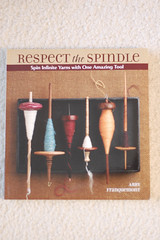First, the facts:
Title: Respect the Spindle: Spin Infinite Yarns with One Amazing Tool
Author: Amy Franquemont
Published by: Interweave Press, 2009
Pages: 135
Type: Spinning.
Chapters:
I. Know About Spindles
1. Choosing a Spindle
2. The Science of Spindles
3. What about the Wheel?
II. Spinning on a Spindle
4. Starting to Spin
5. Fine-tuning Your Yarn
6. Getting More Done
7. Which Spindle When
8. Plying
9. Living with Spindles
III. Spindle-Spun Projects
Pattern Size Range: N/A
The In-Depth Look:
I have a decent assortment of spinning books, including some excellent ones that focus on spindles, but this book blows them away. Not because they’re not good books (because they are), but because of Abby’s sheer conviction for what she does.
You know how they say the best way to learn a foreign language is to completely immerse yourself in the language? To go where it’s spoken, to live it, and breathe it as if there simply is no other language? Well, that’s how the author learned to spin. Unlike many of the rest of us who started spinning for recreation, perhaps as an adjunct to a knitting or weaving habit, Abby learned how to spin as a child, growing up in an Andean village with her anthropologist parents. There, spinning and weaving were not just recreation, but livelihood, and taken very seriously, so she learned from the best.
This book shows off her expertise. She wants all of us to appreciate the skill behind spinning as much as she does. This doesn’t mean it reads like a boring textbook, or anything. It’s incredibly detailed, sure, and goes into (for example) the physics of what makes spinning necessary, why it works, how the whorl affects the spin, all without being impossibly dense and unreadable.
There is fantastic information about spinning in here–details on twist, how to ply with a spindle. Things like how do you choose the right spindle for the kind of yarn you want to make? What’s the best way to wind on a cop? (That’s the bundle of yarn on the spindle.) How should you hold your hands when you draft? Some are things that I’ve read elsewhere, but there is a wealth of information in this book that I have not seen before.
Ultimately, this is a book about spindles, not just about spinning in general. Abby has an entire chapter on “Why not a wheel?” because so many people start spinning and immediately switch over to a spinning wheel, because it’s “faster” or they think it’s easier. But it doesn’t have to be that way. The big difference between wheels and spindles is that one is stationary, one is portable. With a spindle, you can make yarn anywhere. While out for walks. Waiting on line at the post office. On hold on the telephone. Getting lots of little bits of spinning done throughout the day can more than equal what you can get done once you find the time to sit down at your spinning wheel. To boost your output even further, there’s even a chapter about how to get even more spinning done.
The photos are clear and helpful. It’s hard, of course, to demonstrate an active skill like spinning in a still photo, but this book does a good job of it. Some of them are just beautiful to look at, too. There’s a good table of contents, as well as a thorough index, which is something that always makes me happy.
As I said, I have a number of spinning books, and almost all of them are excellent, but they all have different emphases, different objectives. This one is unique, not because of Abby’s love of spindles but because of her perspective. It’s easy to forget that spindles used to be one of mankind’s most important tools, and that in some parts of the world it still is. Spinning yarn has not always been a hobby. For most of us it is, and there’s nothing wrong with that, but the vibe I get here is that the author wants us all to remember that it was, is, and can be so much MORE than “just a hobby.” She is passionate about it, and wants us to be passionate, too.
This book is available from Amazon.com for $15. Don’t miss the companion video, Drafting, either. I haven’t actually seen it, but judging by the quality of Abby’s YouTube videos, I can pretty much guarantee it’s worth while.
Now, if you’ll excuse me, I need to go check out my spindle collection. I haven’t given that turkish spindle a whirl in a while…
Want to see bigger pictures? Click here.

Other posts for this author:



Comments on this entry are closed.
I am interested in learning how to spin. Would you suggest this book (you obviously liked it :) ) or something else? I know that sometimes when books are very in-depth they can sound like gibberish to those who are new to it.
I did like this book. Judith MacKenzie McCuin’s spinning books are wonderful, too. And then, my very first spinning book was Lee Raven’s “Hands On Spinning” which I still think was great.